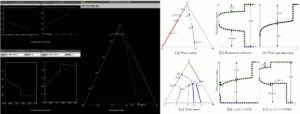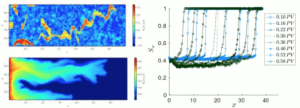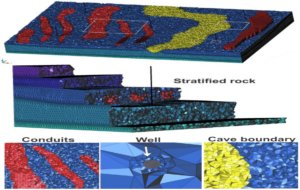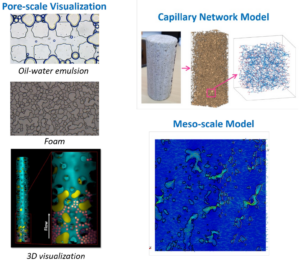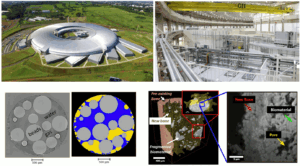- April 21, 2022
- Posted by: Stef Lantin
- Category: Research Spotlight

The Brazilian Research Group in Porous Media Systems working in cooperation with the Brazil InterPore Chapter
The Brazilian Research Group in Porous Media Systems is a non-profit, independent small team of scientists at Universities and Research Institutes in Brazil working on research activities with industrial applications. Tackling complex multiscale, multiphysical problems by developing models, analyzing the behavior of the models, developing accurate numerical methods and software, rigorously analyzing numerical methods, and experimentation makes Brazil a hub of exciting research activity surrounding porous media!
The Brazilian team cooperates with the BR InterPore Chapter activities to promote the InterPore mission (https://www.interpore.org/) of “advancing and disseminating knowledge for understanding, describing, and modeling natural and industrial porous media systems”, focusing on the Brazilian scientific program in the areas of Green World, Smart Materials, Oil Science, Microfluidic and Synchrotron light, Biosciences, Biorenewables, Nanotechnology, Mathematics of Flows in Porous Media, Multiscale Numerical Methods, Numerical Analysis and Scientific Computing.
Here, we highlight a range of recent and developing research areas of the Brazilian Research Team with some representative results and illustrative images. In addition, we also provide some links to more details for interested readers.
FLUID – Laboratory of Fluid Dynamics, IMPA, Rio de Janeiro
In this lab, research focuses on the theory of conservation laws, especially in the context of multiphase flow in porous media (https://impa.br/en_US/pesquisa/dinamica-dos-fluidos/). One application is to develop accurate numerical methods and software for petroleum reservoir simulators, which may be used to optimize oil recovery. The great heterogeneity of the rock in Brazilian pre-salt fields is a great obstacle for oil recovery, reducing the efficiency of conventional recovery. In addition, it is important to keep track of multiple hydrocarbon components in the flow, as well as the chemical composition. The multiphase flow models have non-trivial mathematical difficulties, in part because the system of partial differential equation models is elliptic-hyperbolic. The solution of such conservation laws is important not only for oil recovery in Brazilian pre-salt reservoirs, but also for other applications such as elastoplasticity and magnetohydrodynamics.
Federal University of Juiz de Fora, Minas Gerais
In the Laboratory of Applied Mathematics at the Federal University of Juiz de Fora (LAMAP/UFJF http://lamap.ufjf.br), we work on the physical and mathematical modeling of complex fluid displacement in porous media, such as reactive flows and foam. Using techniques from mathematical analysis and dynamical systems, we develop analytical solutions that improve the understanding of these phenomena and can be used to test and validate commercial simulators. Having exact solutions allows us to build and improve the accuracy of numerical simulations of many physical situations. In order to connect theory and experiments, we investigate parameter uncertainty propagation through the mathematical models and the sensitivity of these models to the constituent parameters.
National Laboratory for Scientific Computation – LNCC, Rio de Janeiro
The COMPORE LAB – Computational Modeling of Porous Materials at LNCC is devoted to developing multiscale computational models for coupled phenomena in porous media (https://www.lncc.br/~murad/). The research focuses on the multi-scale model development, numerical solution and analysis, better understanding of the physics, and education in the general field of coupled phenomena in porous media in collaboration with industry. In this fascinating area our group is highly interested in developing efficient multiscale and mixed-dimensional computational models capable of handling geological complexity such as coupling flow, electrochemistry, transport and geomechanics, with particular emphasis on nano porous media and carbonate rocks. We are also interested in the discretization of a flow problem in a karstified porous medium by using recursive mixed multiscale model reduction for karst conduit-flow in carbonate reservoirs.
Pontifícia Universidade Católica do Rio de Janeiro
The Laboratory of Microhydrodynamics and Flow in Porous Media (LMMP) is focused on fundamental and applied research of free surface flows of complex liquids at the microscale (http://lmmp.mec.puc-rio.br/lmmp/). Polymer solutions, foams, emulsions and dispersions are frequently injected underground for aquifer remediation, reservoir conformance and oil recovery. The effect of the non-linear behavior of complex fluids on fluid displacement in porous media is a direct consequence of pore-level physics. We focus our research on understanding the fundamentals of flow of complex fluids in porous media and how it leads to more uniform displacement patterns. We combine core-flooding experiments, pore-scale flow visualization using optical, confocal microscopy and x-ray microtomography, capillary network modeling and continuous scale modeling to understand these complex flows and how the microscopic phenomena relate to the observed macroscopic flow behavior.
The Brazilian Synchrotron Light Laboratory (LNLS), São Paulo
The LNLS (https://www.lnls.cnpem.br) is part of the Brazilian Center for Research in Energy and Material (CNPEM), located in Campinas, in São Paulo state. LNLS operates the largest and most complex scientific infrastructure built in Brazil, and the only synchrotron light source in Latin America, providing intense light from infrared to hard X-rays. Sirius is an open facility, available to the scientific community. Its state-of-art experimental stations allow researchers to investigate different aspects of natural or artificial materials, such as organic or inorganic structural organization, at multiple scales or distributed hierarchy. The structure of these materials results in unique physicochemical properties. Some examples of these materials are rock, soil, catalysts, batteries, zeolites, biological tissues (e.g. bones and wood), and synthetic materials (e.g. cements and ceramics) – all natural or artificial porous media, which make Sirius a powerful and advanced scientific tool for the international porous media community.
University of Campinas – UNICAMP-IMECC, São Paulo
The research activity at IMECC-UNICAMP is focused on Computational and Applied Mathematics (http://www.ime.unicamp.br/~eabreu/). Nonstandard partial differential equations governing transport phenomena appear frequently in modeling fluid dynamics in multiscale porous media. One research area of focus here is the numerical analysis for numerical methods of partial differential equations used in the simulation of multiscale porous media systems. The models studied appear naturally in basic and applied sciences are related to energy, climate, water, and agriculture. One particular example is the differential equation models used for modeling the extraction of petroleum in reservoirs located in the pre-salt area of the marine coast of Brazil. Challenges specific to geological media include heterogeneities at all scales and discontinuities, while difficulties shared with engineered porous media include complex evolving structures, non-stationary and non-equilibrium dynamics, ill-posed calibration, validation, and coupled multi-physical processes such as multiphase, thermal, and mechanical processes. The developed knowledge and tools are or will be useful for creating a greener world.


